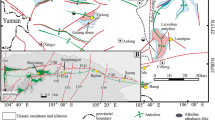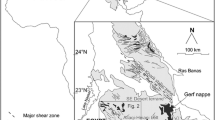Abstract
We report here new sulfur isotope analyses from the Betze-Post-Screamer deposit, the largest Carlin-type gold deposit in the world. Carlin-type deposits contain high concentrations of arsenic, antimony, mercury, tellurium and other elements of environmental interest, and are surrounded by large volumes of crust in which these elements are also enriched. Uncertainty about the source of sulfur and metals in and around Carlin-type deposits has hampered formulation of models for their origin, which are needed for improved mineral exploration and environmental assessment. Previous studies have concluded that most Carlin-type deposits formed from sulfide sulfur that is largely of sedimentary origin. Most of these studies are based on analyses of mineral separates consisting of pre-ore diagenetic pyrite with thin overgrowths of ore-related arsenian pyrite rather than pure, ore-related pyrite. Our SIMS spot analyses of ore-related pyrite overgrowths in the Screamer zone of the Betze-Post-Screamer deposit yield δ34S values of about −1 to 4‰ with one value of about 7‰. Conventional analyses of realgar and orpiment separates from throughout the deposit yield δ34S values of about 5–7‰ with one value of 10‰ in the Screamer zone. These results, along with results from an earlier SIMS study in the Post zone of the deposit and phase equilibrium constraints, indicate that early arsenian pyrite were formed from fluids of magmatic origin with variable contamination from sulfur in Paleozoic sedimentary rocks. Later arsenic sulfides were formed from solutions to which sulfur of sedimentary origin had been added. The presence of Paleozoic sedimentary sulfur in Carlin-type deposits does not require direct involvement of hydrothermal solutions of sedimentary origin. Instead, it could have been added by magmatic assimilation of Paleozoic sedimentary rocks or by hydrothermal leaching of sulfur from wall rocks to the deposit. Thus, the dominant process delivering sulfur, arsenic, gold and mineralizing fluids to Carlin-type systems and their surrounding country rocks was probably separation of fluids from a magmatic source.









Similar content being viewed by others
References
Arehart GB (1996) Characteristics and origin of sediment-hosted, disseminated gold deposits: a review. Ore Geol Rev 11:383–403
Arehart GB, Eldridge CS, Chryssoulis SL, Kesler SE (1993a) Ion microprobe determination of sulfur isotope variations in iron sulfides from the Post/Betze sediment-hosted disseminated gold deposit, Nevada, USA. Geochim Cosmochim Acta 57:1505–1519
Arehart GB, Foland KA, Naeser CW, Kesler SE (1993b) 40Ar/39Ar, K/Ar and fission –track geochronology of sediment-hosted disseminated gold deposits at Post-Betze, Carlin trend, northeastern Nevada. Econ Geol 88:622–646
Arehart GB, Chryssoulis SL, Kesler SE (1993c) Gold and arsenic in iron sulfides from sediment-hosted disseminated gold deposits: Implications for depositional processes. Econ Geol 88:171–185
Arehart GB, Chakurian AM, Tretbar DR, Christensen JN, MacInnes BA, Donelick RA (2003) Evaluation of radioisotopic dating of Carlin-type deposits in the Great Basin, western North America, and implications for deposit genesis. Econ Geol 98:235–248
Bakken BM, Einaudi MT (1986) Spatial and temporal relations between wallrock alteration and gold mineralization, main pit, Carlin gold mine, Nevada, U.S.A. In: MacDonald AJ (ed) Gold ’86. Konsult International, Willowdale, pp 388–403
Bettles KH (1989) Gold deposits of the Goldstrike mine, Carlin trend, Nevada. Society Mining Engineers Preprint 89–158: 14 p
Bowman JR, Parry WT, Kropp WP, Cruer SA (1987) Chemical and isotopic evolution of hydrothermal solutions at Bingham, Utah. Econ Geol 82:395–428
Cail TL, Cline JS (2001) Alteration associated with gold deposition at the Getchell Carlin-type gold deposit, north-central Nevada. Econ Geol 96:1343–1359
Clark LA (1960) The Fe–As–S system—Phase relations and applications. Econ Geol 55:1345–1381
Cline JS, Stuart FM, Hofstra AH, Tretbar DR, Riciputi L, Premo W (2002) He, Nd, and stable isotope constraints on Carlin-type ore fluid components, Getchell NV, USA. Geol Soc America Program with Abstracts (gsa.confex.com/gsa/2002AM/final program/abstract_43002.htm).
Cline JS, Stuart FM, Hofstra AH, Premo W, Riciputi L, Tosdal RM, Tretbar DR (2003) Multiple sources of ore-fluid components at the Getchell Carlin-type gold deposit, Nevada, USA. In: Eliopoulos DG (ed) Mineral exploration and sustainable development. Millpress, Rotterdam, pp 965–968
Cooke DR and Simmons SF (2000) Characteristics and genesis of epithermal gold deposits. Rev Econ Geol 13:221–244
Emsbo P, Hofstra AH, Lauha EA (2000) Jurassic auriferous polymetallic mineralization at the Goldstrike mine, Carlin trend, Nevada. In: Cluer JK, Price JG, Strusacker EM, Hardyman RF, Morris CL (eds) Geology and ore deposits: 2000: the Great Basin and Beyond: geological Society of Nevada Symposium Proceedings, May 15–18, 2000, B2
Emsbo P, Hofstra AH, Lauha EA, Griffin GL, Hutchinson RW (2003) Origin of high-grade gold ore, source of ore fluid components, and genesis of the Meikle and neighboring Carlin-type deposits, northern Carlin trend, Nevada. Econ Geol 98:1069–1107
Ferdock GC, Castor SB, Leonardson RW, Collins T (1997) Mineralogy and paragenesis of ore stage mineralization in the Betze gold deposit, Goldstrike mine, Eureka County, Nevada. Society of Economic Geologists, Guidebook Series 28:75–86
Heinrich CA, Eadington PJ (1986) Thermodynamic predictions of the hydrothermal chemistry of arsenic, and their significance for the paragenetic sequence of some cassiterite-arsenopyirte-base metal sulfide deposits. Econ Geol 81:511–529
Heinrich CA, Driesner T, Stefansson A, Seward TM (2004) Magmatic vapor contraction and the transport of gold from the porphyry environment to epithermal ore deposits. Geology 32:761–764
Hofstra AH (1997) Isotopic composition of sulfur in Carlin-type gold deposits: Implications for genetic models. In: Vikre P, Thompson TB, Bettles K, Christensen O, Parrat R (eds) Carlin-type gold deposits field conference. Society of Economic Geologists Guidebook 28:119–129
Hofstra AH, Cline JS (2000) Characteristics and models for Carlin-type gold deposits. Soc Econ Geol Rev Econ Geol 13:163–220
Hofstra AH, Snee LW, Rye RO, Folger HW, Phinisey JD, Loranger RJ, Dahl AR, Naeser CW, Stein HJ, Lewchuk M (1999) Age constraints on Jerritt Canyon and other Carlin-type gold deposits in the western United States—relationship to mid-Tertiary extension and magmatism. Econ Geol 94:769–802
Ilchik RP, Barton MD (1997) An amagmatic origin of Carlin-type gold deposits. Econ Geol 92:269-288
Kesler SE, Fortuna J, Ye Z, Alt JC, Core DP, Zohar P, Borhauer J, Chryssoulis SL (2003a) Evaluation of the role of sulfidation in deposition of gold: Screamer section of the Betze-Post Carlin-type deposit, Nevada. Econ Geol 98:1137–1158
Kesler SE, Russell N, McCurdy K (2003b) Trace-metal content of the Pueblo Viejo precious-metal deposits and their relation to other high-sulfidation epithermal systems. Mineral Deposita 38:668–682
Kotlyar BB, Singer DA, Jachens RC, Theodore TG (1998) Regional analysis of the distribution of gold deposits in northeast Nevada using NURE arsenic data and geophysical data. In: Tosdal RM (ed) Contributions to the gold metallogeny of the northern Great Basin. U.S. Geological Survey Open-File Report 98–338:234–242
Kuehn CA, Rose AW (1995) Carlin gold deposits, Nevada: origin in a deep zone of mixing between normally pressured and overpressured fluids. Econ Geol 90:17–36
McSween Jr HY, Riciputi LR, Paterson BA (1997) Fractionated sulfur isotopes in sulfides of the Kaidun meteorite. Meteor Planet Sci 32:51–54
Ohmoto H (1972) Systematics of sulfur and carbon isotopes in hydrothermal ore deposits. Econ Geol 67:551–578
Ohmoto H, Goldhaber MG (1997) Sulfur and carbon isotopes. In: Barnes HL (ed) Geochemistry of hydrothermal ore deposits, 3rd ed. Wiley, New York, pp 517–612
Ohmoto H, Rye RO (1979) Isotopes of sulfur and carbon. In: Barnes HL (ed) Geochemistry of hydrothermal ore deposits, 2nd ed. Wiley, New York, pp 517–612
Paterson BA, Riciputi LR, McSween HY Jr (1997) A comparison of sulfur isotope ratio measurement using two ion microprobe techniques, and application to analysis of troilite in ordinary chondrites. Geochim Cosmochim Acta 61:601–610
Pitcairn IK, Ashley MR, Teagle DAH, Green DRH, German CR, Croudace IW, Brewer TS, Craw D (2003) Mobility of Hg, As, Sb, S and C in a metamorphic belt: insights into the source of elements enriched in orogenic gold deposits, the Otago Schists, New Zealand. In: Eliopoulos DG (ed) Mineral exploration and sustainable development. Millpress, Rotterdam, pp 803–806
Radtkde AS, Rye RO, Dickson FW (1980) Geology and stable isotope studies of the Carlin gold deposit, Nevada. Econ Geol 75:641–672
Reich M, Kesler SE, Utsonumiya S, Palenik C, Chryssoulis S, Ewing R (2005) Solubility of gold in arsenian pyrite: an EMPA, SIMS and HRTEM investigation. Geochim Cosmochim Acta (in press)
Ressell MW, Noble DC, Henry CD, Trudel WS (2000) Dike-hosted ores of the Beast deposit and importance of Eocene magmatism in gold mineralization of the Carlin trend, Nevada. Econ Geol 95:1417–1444
Riciputi LR (1996) A comparison of extreme energy filtering and high mass resolution techniques for the measurement of 34S/32S ratios by ion microprobe. Rapid Comm Mass Spec 10:282–286
Riciputi LR, Paterson BA, Ripperdan RL (1998) Measurement of light stable isotope ratios by SIMS: matrix effects for oxygen, carbon, and sulfur isotopes in minerals. Internat Jour Mass Spec 178:81–112
Seedorf E (1991) Magmatism, extension, and ore deposits of Eocene to Holocene age in the Great Basin—Mutual effects and preliminary genetic relationships. In: Geology and ore deposits of the Great Basin symposium geological society of Nevada, Reno, Nevada, Proceedings, pp 133–178
Sillitoe RH, Bonham HF (1990) Sediment-hosted gold deposits: distal products of magmatic hydrothermal systems. Geology 18:157–161
Simon G, Kesler SE, Chryssoulis S (1999) Geochemistry and textures of gold-bearing arsenian pyrite, Twin Creeks, Nevada: implications for deposition of gold in Carlin-type deposits. Econ Geol 94:405–422
Stenger DP, Kesler SE, Peltonen DR, Tapper CJ (1998) Deposition of gold in Carlin-type gold deposits: the role of sulfidation and decarbonatization at Twin Creeks, Nevada. Econ Geol 93:201–216
Tosdal RM (1998) (ed) Contributions to the gold metallogeny of northern Nevada: U.S. Geological Survey Open-File Report 98–338:290 p
Vennemann TW, Muntean JL, Kesler SE, O’Neil JR (1993) Stable isotope evidence for magmatic fluids in the Pueblo Viejo epithermal acid-sulfate Au-Ag deposit, Dominican Republic. Econ Geol 88:55–71
Vikre PG (2000) Subjacent crustal sources of sulfur and lead in eastern Great Basin metal deposits. Geol Soc of America Bull 112:764–782
Ye Z, Kesler SE, Essene EJ, Zohar PB, Borhauer JL (2002) Relation of Carlin-type gold mineralization to lithology, structure and alteration: Screamer zone, Betze-Post deposit, Nevada. Miner Deposit 38:22–38
Acknowledgements
We are grateful to Barrick Goldstrike Mines for access to samples and data on the Screamer system and to Keith Bettles, Eric Lauha, Pam Zohar, and Jeff Borhauer for geological guidance and discussion during all stages of the study. The project was supported by Barrick Goldstrike Mining Company and National Science Foundation grants EAR-9804963 and 0207273. Thanks also to Poul Emsbo for providing information on unpublished sulfur isotope analyses, Al Hofstra and Jean Cline for discussion of the geology and geochemistry of these deposits, John Fortuna for insights resulting from his work at Screamer, Dan Core for carrying out bulk sulfur isotope leachates on one of these samples, and Adrian Boyce, Georges Beaudoin and an anonymous reviewer for suggestions to improve the manuscript.
Author information
Authors and Affiliations
Corresponding author
Additional information
Editorial handling: G. Beaudoin
Rights and permissions
About this article
Cite this article
Kesler, S.E., Riciputi, L.C. & Ye, Z. Evidence for a magmatic origin for Carlin-type gold deposits: isotopic composition of sulfur in the Betze-Post-Screamer Deposit, Nevada, USA. Miner Deposita 40, 127–136 (2005). https://doi.org/10.1007/s00126-005-0477-9
Received:
Accepted:
Published:
Issue Date:
DOI: https://doi.org/10.1007/s00126-005-0477-9




